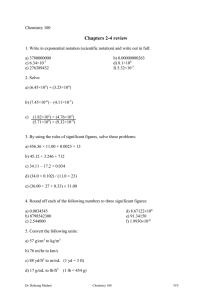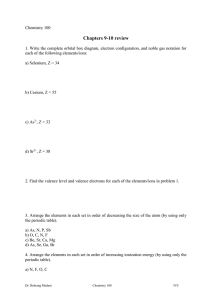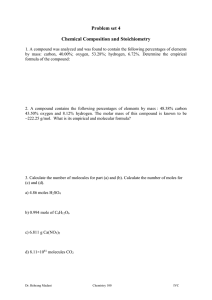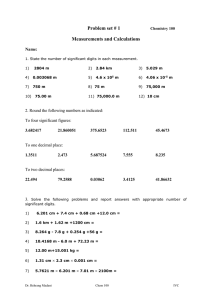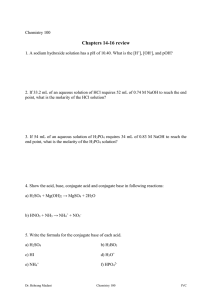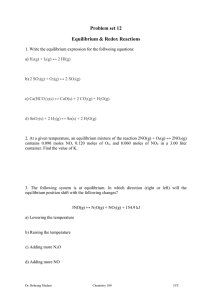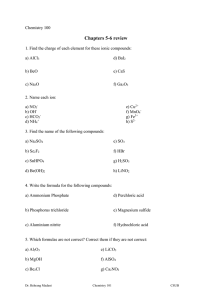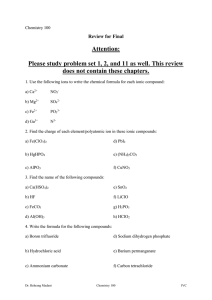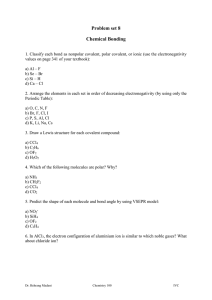Chapters 11-13 review
advertisement
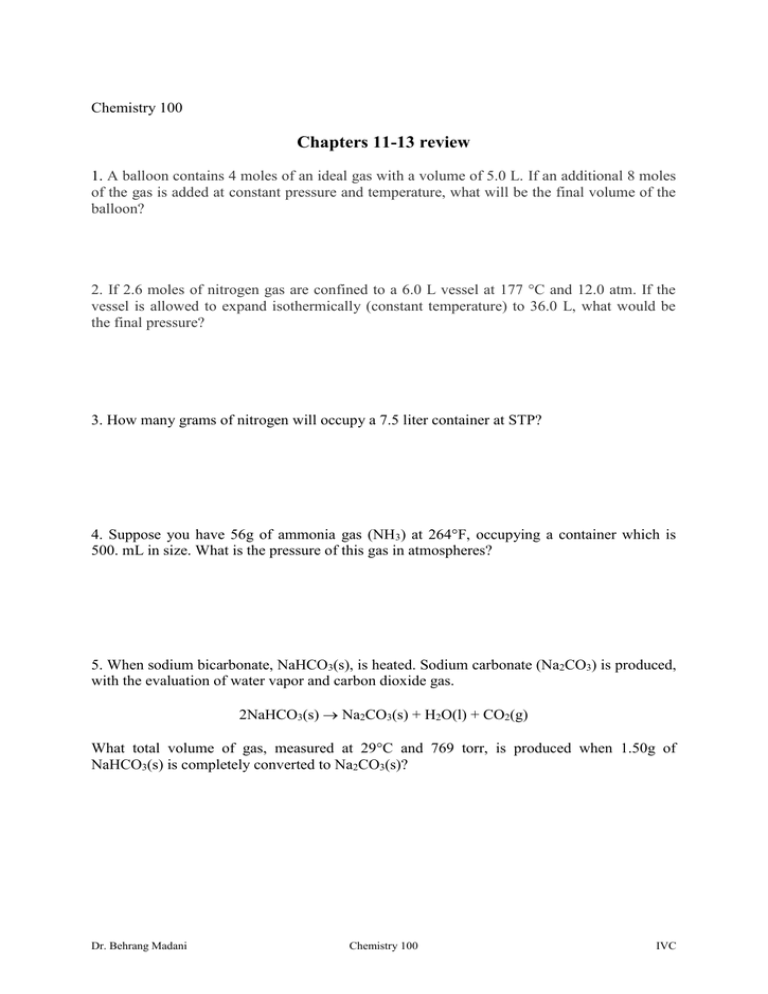
Chemistry 100 Chapters 11-13 review 1. A balloon contains 4 moles of an ideal gas with a volume of 5.0 L. If an additional 8 moles of the gas is added at constant pressure and temperature, what will be the final volume of the balloon? 2. If 2.6 moles of nitrogen gas are confined to a 6.0 L vessel at 177 °C and 12.0 atm. If the vessel is allowed to expand isothermically (constant temperature) to 36.0 L, what would be the final pressure? 3. How many grams of nitrogen will occupy a 7.5 liter container at STP? 4. Suppose you have 56g of ammonia gas (NH3) at 264°F, occupying a container which is 500. mL in size. What is the pressure of this gas in atmospheres? 5. When sodium bicarbonate, NaHCO3(s), is heated. Sodium carbonate (Na2CO3) is produced, with the evaluation of water vapor and carbon dioxide gas. 2NaHCO3(s) Na2CO3(s) + H2O(l) + CO2(g) What total volume of gas, measured at 29C and 769 torr, is produced when 1.50g of NaHCO3(s) is completely converted to Na2CO3(s)? Dr. Behrang Madani Chemistry 100 IVC 6. Suppose that 4.18g of oxygen gas and 3.68g of nitrogen gas are confined in a 11.3-L container at 36°C. What would be the pressure of container? Calculate the partial pressure of each gas in this mixture. 7. A 650.-mL sample of O2 gas at 25°C was prepared by decomposing a 4% aqueous solution of hydrogen peroxide (H2O2): 2H2O2(aq) 2H2O(g) + O2(g) The oxygen thus prepared was collected by displacement of water. The total pressure of gas collected was 862 mm Hg. What is the partial pressure of O2 in the mixture? How many moles of O2 are in the mixture? (The vapor pressure of water at 25°C is 23.8 mm Hg). 8. If 5.2L of argon gas at 56°C and 1.2atm is mixed with 32L of propane gas (C 3H8) at 56°C at 1.2atm in a 12L tank. Calculate the partial pressure of each gas and total pressure in the tank at 56°C. 9. Which substance in each pair has the largest vapor pressure at a given temperature? a) NH3 or PCl3 b) CH3CH2OH or CH3CH2CH2CH3 c) CO2 or HBr Dr. Behrang Madani Chemistry 100 IVC 10. Arrange these compounds in each set in order of increasing boiling points: a) CCl4, Mg(OH)2, CH3OH, H2S CH3 b) CH3-CH2-CH3, CH3-CH2-CH2-CH3, CH3-CH2-CH2-CH2-OH, CH3-C-OH CH3 11. Calculate the energy (in kJ) required to melt 67g of ice, at its normal melting point (0.00°C)? (molar heat of fusion of ice is 6.02 kJ/mol) 12. How much KBr must be used to prepare 250mL of 4.4%(w/v) solution? 13. If a solution is prepared by dissolving 7.7g of lithium iodide, in enough water to make 400mL of solution, what is the %(w/v) of LiI? 14. What is the weight of BaCl2 in a 250 mL bottle of 0.23M BaCl2? 15. Assuming that the volumes are additive, what volume of water must be added to 35mL of 12M HCl to make a solution which is 3.4M? Dr. Behrang Madani Chemistry 100 IVC 16. How do we prepare 3.9L of a 0.012M aqueous solution of NaHSO3? 17. What volume of 0.513 M sulfuric acid solution would be needed to precipitate the barium ion (Ba2+) from 45 mL of 0.121 M BaCl2 solution? BaCl2(aq) + H2SO4(aq) → BaSO4(s) + 2HCl(aq) 18. In questtion17, if 63 mL of an unknown BaCl2 solution is added to 56 mL of 0.51 M H2SO4 solution to have a complete reaction. What was the concentration of the unknown BaCl2 solution? 19. A glucose solution contains 55.8 g glucose (C6H12O6) in 455 g of water. Calculate the freezing point and boiling point of the solution (for water kb = 0.512 ºC/m and kf = 1.86 ºC/m). 20. Determine the concentration of NO2- in each aqueous solution. (Assume complete dissociation of each compound). a. 0.230 M LiNO2 b. 0.230 M Mg(NO2)2 c. 0.230 M Al(NO2)3 Dr. Behrang Madani Chemistry 100 IVC
